|
|
 |
|
Calanoida ( Order ) |
|
|
|
Diaptomoidea ( Superfamily ) |
|
|
|
Pontellidae ( Family ) |
|
|
|
Labidocera ( Genus ) |
|
|
| |
Labidocera detruncata (Dana, 1849) (F,M) | |
| | | | | | | Syn.: | Pontella detruncata (part.) Dana, 1849; Brady, 1883, p.90, figs.F,M, no Pl.XXVI, figs.12, 15);
Labidocera detruncatum : Giesbrecht, 1892 (p.445, 458, 773, figs.F,M); var. Sydney : Dakin & Colefax, 1940 (p.103, figs.F,M); Nyan Taw, 1974 (p.270, Rem.);
Labidocera tenuicauda (F) C.B. Wilson, 1950 (part., p.244, figs.F: juv.);
no Labidocera detruncata var. intermedia : T. Scott, 1894 b (p.82);
no Labidocera detruncata : Dakin & Colefax, 1933 (p.206); Marques, 1949 (p.22, fig.F, Rem.) | | | | Ref.: | | | Giesbrecht & Schmeil, 1898 (p.135, Rem. F,M); Thompson & Scott, 1903 (p.235, 251); Wolfenden, 1905 (1906) (p.1017, figs.F,M); A. Scott, 1909 (p.165); Sewell, 1932 (p.359, figs.F); Farran, 1936 a (p.117); Mori, 1937 (1964) (p.92, figs.F,M); Wilson, 1942 a (p.191, figs.F, juv.M); Sewell, 1947 (p.249); Voronina, 1962 a (p.73, figs.4, 5, 6, Rem.); Grice, 1962 (p.239, figs.F); Tanaka, 1964 c (p.254, Rem.F,M); Fleminger, 1965 (p.122, Rem.); Chen & Zhang, 1965 (p.101, figs.F,M); Saraswathy, 1966 (1967) (p.81); Fleminger, 1975 (p.395); Silas & Pillai, 1973 (1976) (p.774, 797, figs.F,M, Rem.); Goswami & Goswami, 1978 (p.111, figs. caryotypes); Greenwood & Othman, 1979 (p.237, Rem.F,M); Björnberg & al., 1981 (p.660, figs.F,M); Lakkis, 1984 (p.293, figs.F,M, Rem.); Zheng Zhong & al., 1984 (1989) (p.255, figs.F,M); Ohtsuka & Onbé, 1991 (p.214) ; Chihara & Murano, 1997 (p.867, Pl.147,150: F,M); Bradford-Grieve & al., 1999 (p.885, 959, figs.F,M); Bradford-Grieve, 1999 b (p.191, figs.F,M, Rem., figs.184, 194); Mulyadi, 2002 (p.58, figs.F, Rem.); Conway & al., 2003 (p.128, figs.F,M, Rem.).; Vives & Shmeleva, 2007 (p.500, figs.F,M, Rem.); Jeong & al., 2009 (p.513, Rev.F,M, figs.F,M, distribution chart); Hirabayashi & Ohtsuka, 2014 (p.29, Rem: emendation of the Indo-West Pacific species group; Mulyadi, 2014 (p.1629, Rem., Table II) ; Ohtsuka & Nishida, 2017 (p.575, Rem.); Abo-Taleb, 2019 (p.367, 369: Key F, M, Rem., Table 2, figs.F, M). |  issued from: Q.-c Chen & S.-z. Zhang in Studia Marina Sinica, 1965, 7. [Pl.43, 1-4]. Female (from E China Sea): 1, habitus (dorsal); 2, P5 (posterior). male: 3, habitus (dorsal); 4, P5 (posterior).
|
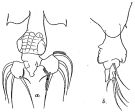 Issued from : R.B.S. Sewell in Mem. Indian Mus., 1932, X (continued). [p.360, Fig.119]. Female (from N Indian): a, urosome (dorsal); b, idem (lateral aspect).
|
 issued from : E.G. Silas & P.P. Pillai in J. mar. biol. Ass. India, 1973 (1976), 15 (2). [p.797, Fig.10]. Female (from Indian Ocean): a, urosome (dorsal); b, rostrum (anterior view); c, P5. Male: d, urosome (part); e, right A1 (distal part); f, right P5; g, left P5.
Scale as in Calanopia minor.
|
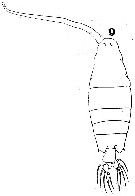 Issued from : W. Giesbrecht in Systematik und Faunistik der Pelagischen Copepoden des Golfes von Neapel und der angrenzenden Meeres-Abschnitte. – Fauna Flora Golf. Neapel, 1892. Atlas von 54 Tafeln. [Taf.41, Fig.9]. Labidocera detruncatum. Female: 9, habitus (dorsal).
|
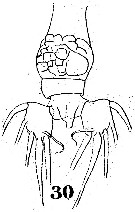 Issued from : W. Giesbrecht in Systematik und Faunistik der Pelagischen Copepoden des Golfes von Neapel und der angrenzenden Meeres-Abschnitte. – Fauna Flora Golf. Neapel, 1892. Atlas von 54 Tafeln. [Taf.41, Fig.30]. Labidocera detruncatum. Female: 30, urosome.
|
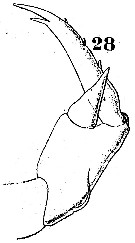 Issued from : W. Giesbrecht in Systematik und Faunistik der Pelagischen Copepoden des Golfes von Neapel und der angrenzenden Meeres-Abschnitte. – Fauna Flora Golf. Neapel, 1892. Atlas von 54 Tafeln. [Taf.25, Fig.28]. Labidocera detruncatum. Female: 28, P5.
|
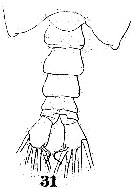 Issued from : W. Giesbrecht in Systematik und Faunistik der Pelagischen Copepoden des Golfes von Neapel und der angrenzenden Meeres-Abschnitte. – Fauna Flora Golf. Neapel, 1892. Atlas von 54 Tafeln. [Taf.41, Fig.31]. Labidocera detruncatum. Male: 31, Th5 and urosome (dorsal).
|
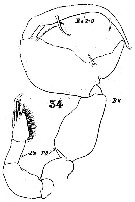 Issued from : W. Giesbrecht in Systematik und Faunistik der Pelagischen Copepoden des Golfes von Neapel und der angrenzenden Meeres-Abschnitte. – Fauna Flora Golf. Neapel, 1892. Atlas von 54 Tafeln. [Taf.23, Fig.34]. Labidocera detruncatum. Male: 34, P5 (anterior view).
|
 Issued from : W. Giesbrecht in Systematik und Faunistik der Pelagischen Copepoden des Golfes von Neapel und der angrenzenden Meeres-Abschnitte. – Fauna Flora Golf. Neapel, 1892. Atlas von 54 Tafeln. [Taf.23, Fig.14]. Labidocera detruncatum. Male: 14, A1 (distal part, ventral view).
|
 issued from : T. Mori in The pelagic Copepoda from the neighbouring waters of Japan, 1937 (2nd edit., 1964). [Pl.42, Figs.1-6]. Female: 4, P5; 5, habitus (dorsal). Male: 1, habitus (lateral); 2, right A1; 3, P5; 6, urosome (dorsal).
|
 issued from : G.D. Grice in Fish. Bull. Fish and Wildl. Ser., 1962, 61. [p.238, Pl.34, Figs.8-10]. Female (from equatorial Pacific): 8, posterior part o thorax and urosome (dorsal); 9, same (lateral; 10, P5. Nota: The lateral margins of the last thoracic segment are pointed. Genital segment asymmetrical.
|
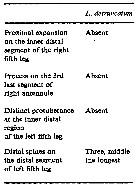 issued from : Nyan Taw in Austr. J. mar. Freshwat. Res., 1974, 25. [p.270, Table 1]. As Labidocera detruncatum. Male: Characteristics.
|
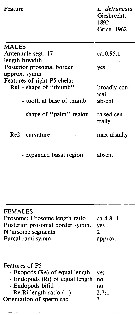 issued from : J.G. Greenwood & B.H.R. Othman in J. Plankton Res., 1979, 1 (1). [p.237] Characters in L. detruncata compared with other species within the super-species detruncata (see L. cervi, L. farrani, L. caudata, L. pavo, L. bataviae, L. madurae and L. sinolobata, with reference sources).
|
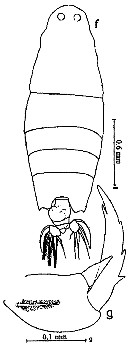 issued from : Mulyadi in Treubia, 2002, 32; [p.54, Fig.15 f-g]. Female (from E Indonesian waters): f, habitus (dorsal); g, P5.
|
 issued from : Mulyadi in Treubia, 2002, 32; [p.59, Table 2]. Characteristics features of L. detruncata in Indo-West Pacific. Comparison with L. kroyeri, L. minuta and L. pectinata (see at these species).
|
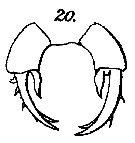 Issued from : G.S. Brady in Rep. Scient. Results Voy. Challenger, Zool., 1883, 8 (23). [Pl. XLV, Fig.20]. As Pontella detruncataFemale: 20, P5.
|
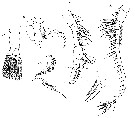 Issued from : G.S. Brady in Rep. Scient. Results Voy. Challenger, Zool., 1883, 8 (23). [Pl. XXVI, Figs. 8-11, 13-14]. As Pontella detruncata. Male: 8, left A1; 9, right A1; 10, 11, denticulated plates of the geniculation of right A1 (highly magnified); 14, urosome.
|
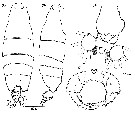 Issued from : H.G. Jeong, H.-L. Suh, S.B. Jeong, Y.H. Yoon & H.Y. Soh in Zoological Studies, 48 (4). [p.514, Fig.5]. Female (from 34°30'N, 128°E): A-B, habitus (dorsal and lateral, respectively); C, urosome (ventral); D, P5 (L = left leg; R = right leg). Nota: Urosome 2-segmented, genital compound somite resulting from incompletely fusion of genital double-somite and 2nd urosomite, dorsal surface uneven, lined, and notched; genital operculum located posteromedially. Anal somite with large posterior anal flap. Caudal rami with 2nd innermost terminal seta swollen proximally. P5 symmetrical, coxa and intercoxal sclerite completely fused; exopod uni-segmented, with 3 outer processes and 2 unequal apical processes; endopod uni-segmented and conical.
|
 Issued from : H.G. Jeong, H.-L. Suh, S.B. Jeong, Y.H. Yoon & H.Y. Soh in Zoological Studies, 48 (4). [p.519, Fig.9, B]. Female: Scanning eletron micrograph of rostrum (ventral view). Scale bar = 100 µm.
|
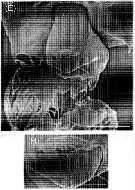 Issued from : H.G. Jeong, H.-L. Suh, S.B. Jeong, Y.H. Yoon & H.Y. Soh in Zoological Studies, 48 (4). [p.519, Fig.9, E-H]. Female: Scanning electon micrographs ot the genital area. Scale bars: 200 µm (E); 50 µm (H).
|
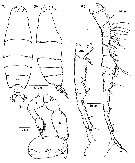 Issued from : H.G. Jeong, H.-L. Suh, S.B. Jeong, Y.H. Yoon & H.Y. Soh in Zoological Studies, 48 (4). [p.515, Fig.6]. Male: A-B, habitus (dorsal and lateral, respectively); C, right A1; D, ancestral segments XIX-XXIV of right A1; E, P5 (L = left leg; R = right leg). Nota: Caudal rami symmetrical with 6 unmodified setae. P5 uniramous, asymmetrical; coxa of right exopod coalescent into intercoxal sclerite; basis with small proximal outer seta; right exopod 2-segmented, 1st segment bearing 2 spines one of which is distal and the other lying at base of thumb; 2nd segment with 3 elongate setae curved inward; left exopod 2-segmented, 1st segment with distolateral process; 2nd segment with 4 spine-like apical processes and inner hirsute border.
|
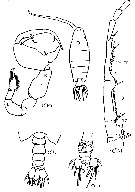 Issued from : J.M. Bradford-Grieve, E.L. Markhaseva, C.E.F. Rocha & B. Abiahy in South Atlantic Zooplankton, edit. D. Boltovskoy. 1999, Vol. 2, Copepoda; [p.1068, Fig. 7.384: Labidocera detruncata]. Ur = urosome; B = basis; r = right; l = left leg. Female characters (from key p.959): - Posterior prosome corners produced into large rounded lobes with lateral spines in dorsal view. - Anterior cephalosome without crest, rounded in dorsal view. - Cephalosone without lateral hook. Male characters (from key, p.959): - Right P5 exopodal segment 1-2 without process between 'thumb' and distal border of segment. - Left P5 terminal segment with 3-4 distal spines. - Right P5 basis relatively short, shorter than or only slightly longer than exopodal segment 1. - Left P5 basis not especially produced distally.
|
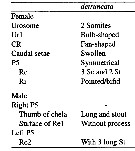 Issued from : Mulyadi in Crustaceana, 2014, 87 (14). [p.1630, Table II]. Characteristic features of L. detruncata compared with five species in the sub-groups in Indo-Australian region. Compare with L. cervi, sinilobata, kaimanaensis and farrani
|
 Issued from : H.A. Abo-Taleb in Egyptian J. Aqua. Res., 2019, 45. [p.369]. Key to species of Labidocera in the Red Sea. Female: 1 - Anterior end of cephalosome rounded without median crest. 2 - Lateral hooks on cephalosome absent. 3 - Urosome 3-segmented. 4 - 1st urosomite (genital compound) large with left dorsal swelling. Male: 1 - Anterior end of cephalosome rounded without a median crest. 2 - Last posterolateral end of metasome almost symmetrical. 3 - Left P5 terminal segment with 4 terminal spines, one of which is longer.
| | | | | Compl. Ref.: | | | Carl, 1907 (p.17); Sewell, 1948 (p.322, 451); C.B. Wilson, 1950 (part., p.244); Krishnaswamy, 1953 (p.134); Chiba & al., 1957 (p.308); 1957 a (p.11); Yamazi, 1958 (p.152, Rem.); Heinrich, 1960 a (p.46: fig.2); Fagetti, 1962 (p.34); Ganapati & Shanthakumari, 1962 (p.9, 15); Sherman, 1963 (p.216: fig.2, p.217: fig.4, p.221: fig.10, p. 223: fig.13, p. 224: fig.14); Heinrich, 1964 (p.86: fig.4, p.91: fig.7); Anraku & Azeta, 1965 (p.13, Table 2, fish predator); Grice & Hulsemann, 1967 (p.19); Fleminger, 1967 a (tabl.1); Sherman & Schaner, 1968 (p.583, fig.1); Heinrich, 1969 (p.1457, fig.1); Itoh, 1970 (tab.1); Brodsky, 1972 (p.256); Bainbridge, 1972 (p.61, Appendix Table I: vertical distribution vs day/night); Weikert, 1975 (p.137, carte); Lakkis, 1976 (p.83: Rem.); Carter, 1977 (1978) (p.36); Grice & Gibson, 1978 (p.23, tab.8); Kovalev & Shmeleva, 1982 (p.85); Dessier, 1983 (p.89, Tableau 1, Rem., %); Guangshan & Honglin, 1984 (p.118, tab.); Lakkis, 1984 (p.289, tab.II); Moraitou-Apostolopoulou, 1985 (p.303, occurrence/abundance in E Mediterranean Sea, Rem.: p.313); Madhupratap & Haridas, 1986 (p.105, 112: Rem., tab.1); Brinton & al., 1986 (p.228, fig.11: spatial distribution, Table 1); Renon, 1987 (tab.2); Dessier, 1988 (tabl.1); Hernandez-Trujillo, 1989 (tab.1); Cervantes-Duarte & Hernandez-Trujillo, 1989 (tab.3); Othman & al., 1990 (p.565, Rem.); Mizushima, 1990 (fig.2, 3, tab.2); Hernandez-Trujillo, 1994 (tab.1); Shih & Young, 1995 (p.71); Mauchline, 1998 (p.507); Padmavati & al., 1998 (p.349); Suarez-Morales & Gasca, 1998 a (p.110); Wong & al, 1998 (tab.2); Fernandez-Alamo & al., 2000 (p.1139, Appendix); Hwang & al., 2003 (p.193, tab.2); Lan & al., 2004 (p.332, tab.1); Lo & al.*, 2004 (p.218, tab.1, fig.6); Gallienne & al., 2004 (p.5, tab.3); Lo & al., 2004 (p.89, tab.1); Zenetos & al., 2005 (p.63, Rem.: p.82, casual occurrence); Zuo & al., 2006 (p.163: tab.1); Hwang & al., 2006 (p.943, tabl. I); Kovalev, 2006 (p.67: Lessepsian migration); Hwang & al., 2007 (p.25); Dur & al., 2007 (p.197, Table IV); Tseng & al., 2008 (p.402, Table 2); Zenetos & al., 2010 (p.397); W.-B. Chang & al., 2010 (p.735, Table 2, abundance); Maiphae & Sa-ardrit, 2011 (p.641, Table 2, 3, Rem.); Tutasi & al., 2011 (p.791, Table 2, abundance distribution vs La Niña event); Tseng L.-C. & al., 2011 (p.47, Table 2, occurrences vs mesh sizes); Mulyadi & Rumengan, 2012 (p.202, Rem.: p.204); in CalCOFI regional list (MDO, Nov. 2013; M. Ohman, comm. pers.); Hirai & al., 2013 (p.1, Table I, molecular marker); Jerez-Guerrero & al., 2017 (p.1046, Table 1: temporal occurrence); Abo-Taleb & Gharib, 2018 (p.139, Table 5, occurrence %); Palomares-Garcia & al., 2018 (p.178, Table 1: occurrence).
| | | | NZ: | 16 | | |
|
Distribution map of Labidocera detruncata by geographical zones
|
| | | | | | | | | | | | 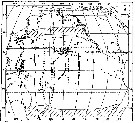 issued from : A.K. Heinrich in Zool. Zh., 48 (10) [p.1458, Fig.1]. issued from : A.K. Heinrich in Zool. Zh., 48 (10) [p.1458, Fig.1].
Distribution of two species of Pontellidae in the Pacific Ocean.
1: occurrence of Labidocera detruncata; 2: occurrence of Epilabidocera longipedata; 3: stations. |
 Issued from : H.A. Abo-Taleb in Egyptian J. Aquat. Res., 2019, 45. [p.371, Table 2]. Issued from : H.A. Abo-Taleb in Egyptian J. Aquat. Res., 2019, 45. [p.371, Table 2].
Average values with standard deviation and ranges (individuals/m3) in the different studied habitats (SG: seagrass, CR: coral reef, SSL: sheltered lagoon, and OW: open sea.
See Labidocera euchaeta fig.1: sampling sites and Table 1: measured physical environmental parameters in the northern Red Sea. |
| | | | Loc: | | | South Africa (E), Patagonia, SW Atlant., G. of Guinea (in Bainbridge, 1972, p.91: rare), Yucatan, Caribbean, off Cape Cod, Georges Bank, E Medit. (Lebanon Basin), Red Sea, Hurghada (shallow sheltered lagoon), Arabian Sea, Is. Laccadive Is., Maldive Is., Sri Lanka, Mascarene Basin, Natal, Madagascar (Nosy Bé), Rodrigues Is. - Seychelles, Indian, India (Lawson's Bay, Madras), Bay of Bengal, Nicobar Is., Nankauri Harbour, Birmania, G. of Thailand, Indonesia (Indonesian waters, Lombok Is., Ambon Bay, NE Celebes), Philippines, Viet-Nam (Cauda Bay), Gulf of Tonkin, China Seas (East China Sea, South China Sea), Taiwan (S, E, SW, NW, N, Mienhua Canyon), S Korea, Japan, Nagazaki, Tanabe Bay, Shikoku Is., Bikini Is., Alaska W, Pacif. (W equatorial), Australia (G. of Carpentaria, Great Barrier), New Caledonia, New Zealand (off North Island N), Kermadec Is, Pacif. (equatorial), off California, W Baja California, La Paz, G. of California, G. of Tehuantepec, Clipperton Is., America (central), W Colombia, Bahia Cupica (Colombia), off Samoa, Hawaii, Tuamotu Is., NW Marquesas Is., Galapagos-Ecuador, off Chile. | | | | N: | 102 | | | | Lg.: | | | (34) F: 2,46; M: 2,4; (46) F: 2,8-2,25; M: 2,5-2,15; (78) F: 2,4; M: 2,6; (91) F: 2,5; M: 2,2; (101) F: 2,72; 2,68; (120) F: 2,77-2,52; M: 2,53-2,36; (290) F: 2,25-2,75; M: 2,25-2,3; (530) F: 2,4; M: 2,3; (795) F: 2,2; M: 2,2; (866) M: 2,25-2,61; (909) F: 2,6-2,72; M: 2,52-2,7; (991) F: 2,42-2,72; M: 2,2-2,7; (1026) F: 2,56-2,75; M: 2,44; (1087) F: 2,72; {F: 2,20-2,80; M: 2,15-2,70} | | | | Rem.: | epipelagic.
The presence of this species in the Eastern Mediterranean could be due to the Suez Canal. Its presence in the Red Sea is to be confirmed.
Vives & Shmeleva, (2007,p.501) report this species from Naples.
For Itoh (1970 a, fig.2, from co-ordonates) the Itoh's index value of the mandibular gnathobase = 735.
This species belongs to the L. detruncata group (Fleminger, 1967).
Ohtsuka & Nishida (2017, p.575) point to a comprehensive speciation pattern was proposed for the Indo-Pacific coastal L. pectinata species complex, based on vicariant events in accord with eustatic changes in sea level during the Pleistocene (< - 2.6 million years)) (Flemi,ger, 1986), such a vicariant mechanism is applicable to L. detruncata species complexes.
Abo-Taleb (2019, p.373 underlines that this species from Indo-Malaysian region origin was transported to the western Atlantic through the passage of Panama as confirmed by Ohtsuka & Reid (1998) and Jeong & al. (2009).
See in DVP Conway & al., 2003 (version 1) | | | Last update : 07/12/2020 | |
|
|
 Any use of this site for a publication will be mentioned with the following reference : Any use of this site for a publication will be mentioned with the following reference :
Razouls C., Desreumaux N., Kouwenberg J. and de Bovée F., 2005-2025. - Biodiversity of Marine Planktonic Copepods (morphology, geographical distribution and biological data). Sorbonne University, CNRS. Available at http://copepodes.obs-banyuls.fr/en [Accessed December 27, 2025] © copyright 2005-2025 Sorbonne University, CNRS
|
|
 |
 |


























